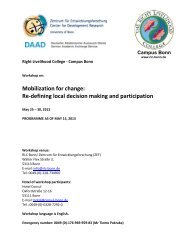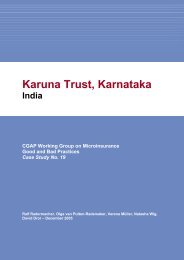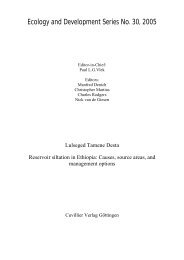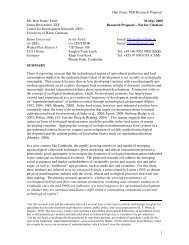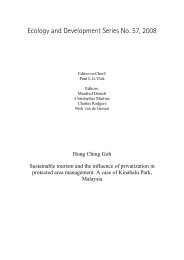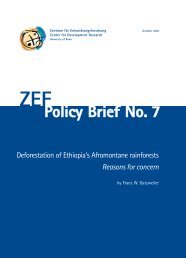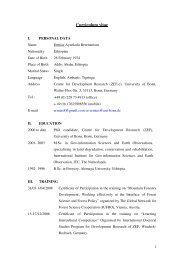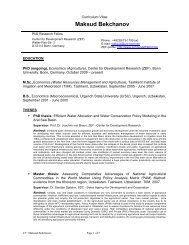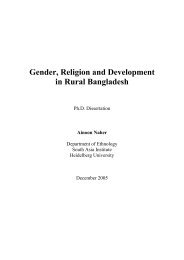- Page 1: Ecology and Development Series No.
- Page 4 and 5: Wäldern weist im Wesentlichen zwei
- Page 6 and 7: 4.4 Discussion ....................
- Page 8 and 9: General introduction1 GENERAL INTRO
- Page 10 and 11: General introductionoutbreaks and e
- Page 12 and 13: General introductionunfavorable cha
- Page 14 and 15: General introductionand their patte
- Page 16 and 17: Current state of knowledge2 STATE O
- Page 18 and 19: Current state of knowledgeThe studi
- Page 20 and 21: Current state of knowledgemore prom
- Page 22 and 23: Current state of knowledge2.2 Taxon
- Page 24 and 25: Current state of knowledgekapakata,
- Page 26 and 27: Current state of knowledgecultivars
- Page 28 and 29: Current state of knowledgehomegarde
- Page 30 and 31: Current state of knowledgeseeded pl
- Page 32 and 33: Current state of knowledgeHailu, un
- Page 34 and 35: Current state of knowledgeraces are
- Page 36 and 37: Description of the study area and s
- Page 40 and 41: Description of the study area and s
- Page 42 and 43: Floristic analysis of the undisturb
- Page 44 and 45: Floristic analysis of the undisturb
- Page 46 and 47: Floristic analysis of the undisturb
- Page 48 and 49: Floristic analysis of the undisturb
- Page 50 and 51: Floristic analysis of the undisturb
- Page 52 and 53: Floristic analysis of the undisturb
- Page 54 and 55: Floristic analysis of the undisturb
- Page 56 and 57: Floristic analysis of the undisturb
- Page 58 and 59: Floristic analysis of the undisturb
- Page 60 and 61: Floristic analysis of the undisturb
- Page 62 and 63: Floristic analysis of the undisturb
- Page 64 and 65: Floristic analysis of the undisturb
- Page 66 and 67: Floristic analysis of the undisturb
- Page 68 and 69: Floristic analysis of the undisturb
- Page 70 and 71: Floristic analysis of the undisturb
- Page 72 and 73: Floristic analysis of the undisturb
- Page 74 and 75: Impacts of human use on the forest
- Page 76 and 77: Impacts of human use on the forest
- Page 78 and 79: Impacts of human use on the forest
- Page 80 and 81: Impacts of human use on the forest
- Page 82 and 83: Impacts of human use on the forest
- Page 84 and 85: Impacts of human use on the forest
- Page 86 and 87: Impacts of human use on the forest
- Page 88 and 89:
Impacts of human use on the forest
- Page 90 and 91:
Impacts of human use on the forest
- Page 92 and 93:
Impacts of human use on the forest
- Page 94 and 95:
Impacts of human use on the forest
- Page 96 and 97:
Impacts of human use on the forest
- Page 98 and 99:
Impacts of human use on the forest
- Page 100 and 101:
Impacts of human use on the forest
- Page 102 and 103:
Impacts of human use on the forest
- Page 104 and 105:
Impacts of human use on the forest
- Page 106 and 107:
Conservation of the wild Coffea ara
- Page 108 and 109:
Conservation of the wild Coffea ara
- Page 110 and 111:
Conservation of the wild Coffea ara
- Page 112 and 113:
Conservation of the wild Coffea ara
- Page 114 and 115:
Conservation of the wild Coffea ara
- Page 116 and 117:
Conservation of the wild Coffea ara
- Page 118 and 119:
Conservation of the wild Coffea ara
- Page 120 and 121:
Conservation of the wild Coffea ara
- Page 122 and 123:
Conservation of the wild Coffea ara
- Page 124 and 125:
Conservation of the wild Coffea ara
- Page 126 and 127:
Conservation of the wild Coffea ara
- Page 128 and 129:
Conservation of the wild Coffea ara
- Page 130 and 131:
Conservation of the wild Coffea ara
- Page 132 and 133:
Conclusions and recommendations7 CO
- Page 134 and 135:
Conclusions and recommendations3. R
- Page 136 and 137:
ReferencesBatisse M. 1986 Developin
- Page 138 and 139:
ReferencesDavis A.P. and Rokotonaso
- Page 140 and 141:
ReferencesESRI. 1996. ArcView GIS:
- Page 142 and 143:
ReferencesIUCN 1992. Protected Area
- Page 144 and 145:
ReferencesMesfin Ameha and Bayetta
- Page 146 and 147:
ReferencesSmith R.F. 1985. A histor
- Page 148 and 149:
ReferencesVan Jaarsveld A.S., Freit
- Page 150 and 151:
Appendices9 APPENDICESAppendix 1 Li
- Page 152 and 153:
AppendicesD. repandum (Vahl) DC, [H
- Page 154 and 155:
AppendicesSapotaceaeAningeria altis
- Page 156 and 157:
AppendicesAppendix 3 Families of va
- Page 158 and 159:
AppendicesAppendix 5. ANOVA tables:
- Page 160 and 161:
AppendicesAppendix 7 Height class d
- Page 162 and 163:
AppendicesGFUNDFOR OLSFOR SF-NEW SF
- Page 164 and 165:
AppendicesAppendix 10. List of loca
- Page 166 and 167:
AppendicesNumber Family name Scient
- Page 168 and 169:
AppendicesNumber Family name Scient
- Page 170 and 171:
ACKNOWLEDGEMENTSI am very grateful



